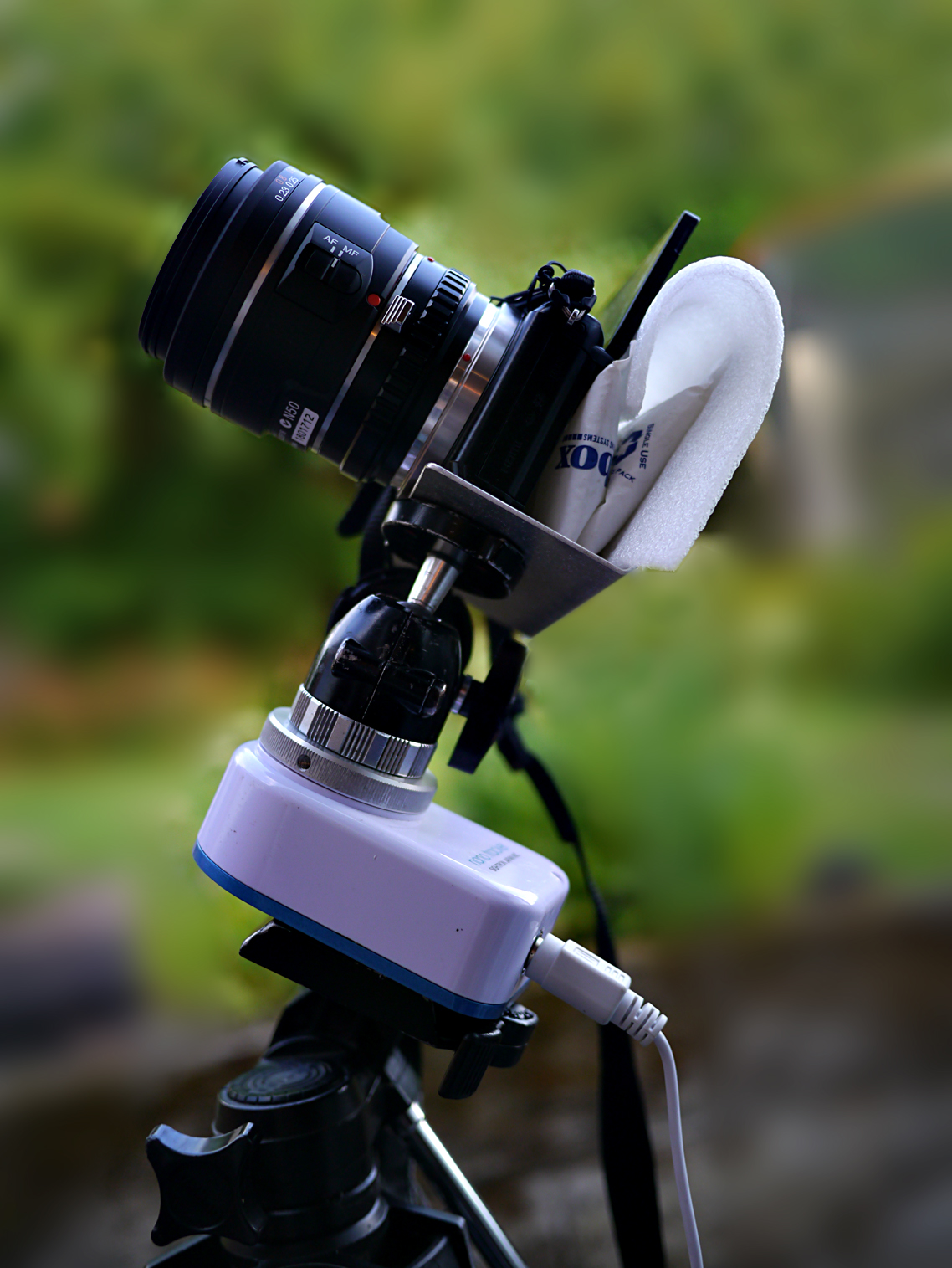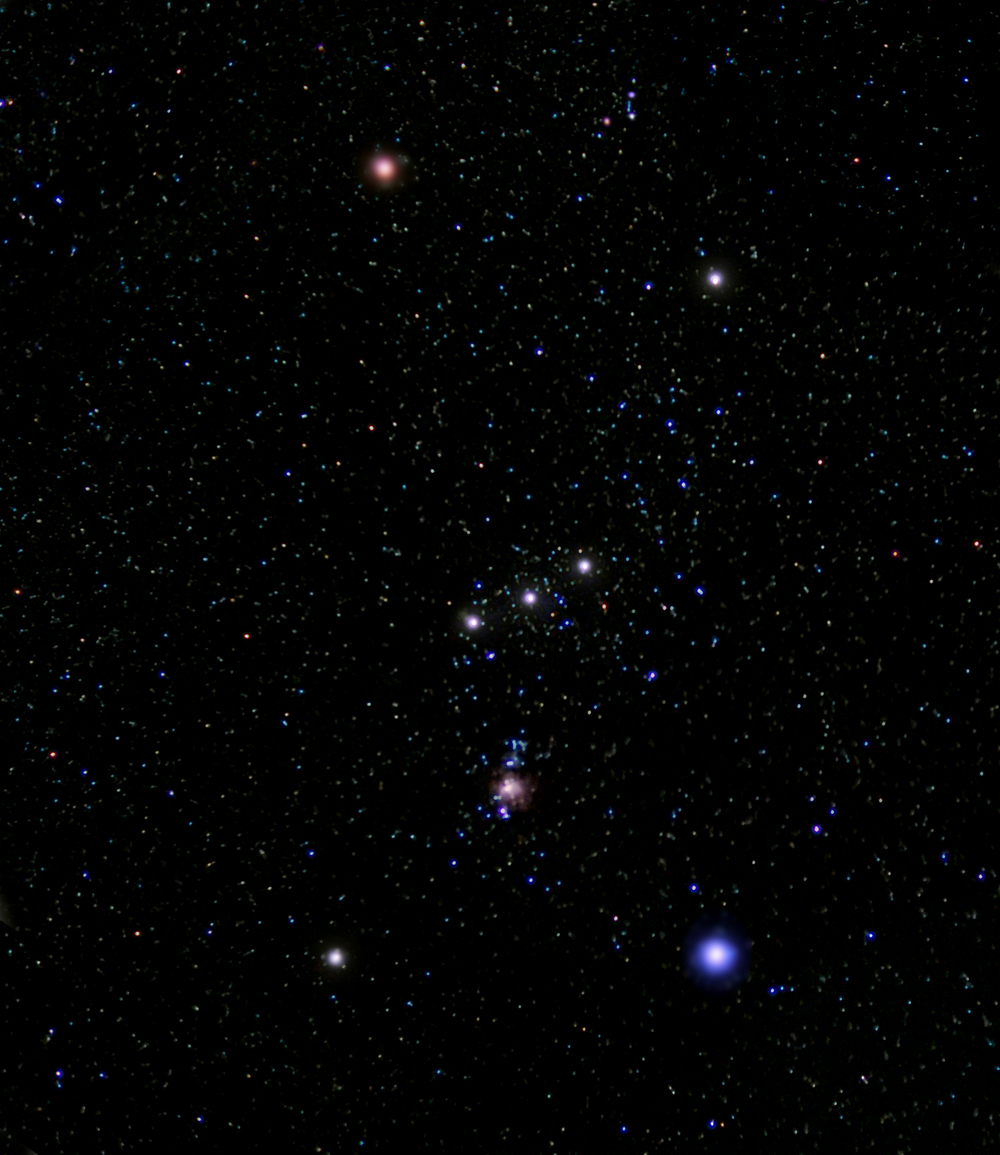JULY 2018
The Sony A5000 APS-C mirrorless camera – an astrophotography bargain?
This is one of ~60 illustrated articles to be found in the author’s Astronomy Digest.

Sony A5000 camera with a ‘K&F Concept’ adapter to enable it to accept prime Sony A-mount lenses. A thin aluminium bracket was made to hold a small ice pack (folded in two) against the back of the camera. Insulation should be applied between the ice pack and bracket. The camera is mounted on a ‘nano tracker’.
I recently bought a used A5000 camera as I thought that it might be good for taking out to dark sky sites for wide field imaging. I now realise that I have bought a real bargain. Though now several years old, they can still be bought at relatively low cost either with a very good 16 – 50 mm image stabilized zoom (24 – 75 mm effective focal length) or as a body alone. The former provides a very high quality camera for day to day use as well as for astrophotography. With suitable adapters, the latter (or the former) can be used with a wide range of prime lenses for wide field astrophotography or with a T-mount for use with a telescope. The K&F Concept Sony A to E mount adapter used in the image above (highly recommended) does allow the aperture to be easily adjusted which is quite useful. The aperture control is ‘click-controlled’ which allows it to be calibrated and it appears that, for my f1.8 A-mount lenses, 2 clicks equal one stop. So one can visually set the lens to full aperture and click the aperture control clockwise (as seen from the front) to stop down. [The K&F Concept Nikon to E mount adapter also allows the aperture of many Nikon lenses to be adjusted .] The camera is, of course, used in manual mode. As I have both a Nikon to Sony E-mount adapter and a Nikon T-mount these can be simply combined to provide a T-mount for the Sony camera so it has not been necessary to purchase a specific T-mount if the camera is to be used with a telescope.
The Sony A-mount cameras seem to be less in demand now as their E-mount mirrorless cameras have become more popular and I have found several Sony A-mount lenses second hand at surprisingly low cost, using them with the K&F Concept Sony A to E mount adapter. The Samyang (or Rokinon) 12 mm f/2.0 ultra wide angle lens is available for Sony E mount cameras (at around £200) and is highly regarded.
The camera body can be purchased in excellent condition second hand, for ~ £140 (from Camera Jungle or MPB in the UK). For day to day use, the 16-50 mm image stabilised kit lens zoom can be purchased in excellent condition for ~£86 (Camera Jungle again). Its performance is fine but it is apparently slightly fragile so should not be dropped! The Sony 55 to 210 f/4.5 to f/6.3 zoom lens is a relatively small lens with good performance. So these two could cover most situations. I have also been able to use my Zeiss Contax G 45 mm f/2 Planar lens with adaptor to provide a short telephoto prime lens of superb quality.
The 20.4 megapixel Sony Exmore sensor has very low inherent noise and is ISO invariant. (See article in the digest− ‘What ISO to use for Astrophotography’.) In fact, these new CMOS sensors exhibit similar noise levels at room temperature as, for example, the widely used Kodak 8.3 megapixel CCD sensor at -20 Celcius. However, of course, the sensor temperature and dark current noise will rise as a sequence of exposures are made whereas the cooled CCD sensor will remain at the same temperature making the taking of dark frames easy. The taking of dark frames is a problem when using DSLRs or Compact System Cameras such as the A5000 as the sensor temperature increases for quite some time as a continuous sequence of frames is taken. There is a very exhaustive article ‘The use of Dark Frames when using a DSLR’ in the digest. Some simple to apply advice is:
If imaging on a cold winter night, just spend all the imaging time taking ‘light’ frames. Do not use the ‘in camera noise reduction’ feature. Do not worry about taking dark frames. [This means that all the imaging time is capturing photons from the sky and so averaging a large number of, say, 30 second exposures will reduce the background noise levels in any case.]
If imaging on a warm summer night, use the ‘in camera noise reduction’ feature which takes individual dark frames which are applied to each ‘light’ frame in camera. [This will halve the time capturing photons and each dark frame will introduce some additional noise into the image but overall may produce a less noisy image.]

I found an initial problem with A5000 in that it does not, in its menus, allow one to turn off the ‘in camera noise reduction’ mode which, in principle, would not allow it to be disabled on cold nights. However, there is a ‘work around’. In ‘Manual’ imaging mode, the ‘9 o’clock point on the rotary dial should be depressed which brings up a ‘Drive Mode’ menu on the left of the screen. If the bottom of the dial is then clicked the various possibilities are scrolled through until ‘BRK C 0.3ev’ is highlighted. This mode is then selected by pressing the button in the centre of the dial. The camera then no longer applies the long exposure noise reduction.
Bulb Exposures
I have been capturing exposures of 30 seconds in length and then stack a very large number (100 in a recent imaging exercise) in Deep Sky Stacker. This means that any single frame, perhaps including a satellite track or having bumped the tripod, can be removed from the stack without any real effect on the result. [I take both Jpeg and Raw so that I can easily scan through the individual frames.] Theoretically, stacking fewer longer exposures should give a somewhat better result in which case the bulb mode is employed. As the internal heating of the camera is largely produced when the camera is processing the data acquired from the sensor, I suspect that taking fewer, longer, exposures will give a reduced sensor temperature rise and hence less noise in the images. Perhaps I should change my strategy!
There has been much discussion in the forums that, in the later Sony cameras when the bulb mode is used (and possibly even on exposures longer than 3.5 seconds), a form of spatial filtering is applied to the raw images to reduce noise but which could result in the removal of faint stars. (The ‘Sony Star Eater’ problem.) Happily, there is no evidence that this is applied in the case of the A5000, perhaps due to it having a less powerful processor than later Sony cameras. Good.
WiFi control from a tablet.
The A5000 allows the camera to be controlled over WiFi from an App running on a phone or tablet. [I use an App called ‘TimeLapse’ on my Samsung Android tablet.] The App can act as an intervalometer to take a continuous sequence of frames and, by giving (in the case of a tablet) a large display of the captured frames allows an accurate focus to be achieved. [A visual indicator of correct focus is when faint stars appear in the captured frame.]
Cooling
The A5000 has one real advantage over many other cameras that might be used. The screen lifts right up (which can help selecting an area of sky if the camera is pointing near the zenith) but also, more importantly, it means that the heat path from the computers logic board to the back face of the camera is short. So, if the screen is lifted, the camera’ temperature will not increase as much. But there are further advantages. In summer with warm ambient temperatures, a thin ‘flexible’ (when liquid) ice pack could be placed against the camera’s back wall as in the image above. In winter, a heat sink could be attached with thermal paste to the back wall to help dissipate the heat. If the camera is used with plenty of power available, perhaps systems used to cool PC CPUs could be applied such as a water cooled system (which uses Peltier cooling to cool a circulating liquid) or even a Peltier unit applied directly onto the back face of the camera.
Batteries
A minor point perhaps, but some new cameras will only allow their own batteries (usually quite expensive and typically £55 for this camera) to be used but the A5000 allows similar specification batteries such as that made by Duracell to be acquired for ~£20. ‘Dummy’ batteries which take 5 volts through a USB connection can be obtained at low cost and their use also helps to minimise heating of the camera. There are two ways to power 5 volt dummy battery in the field. Many of the car ‘jump start’ batteries as well as having 12 volt sockets also have a 5 volt USB port, so one of these could be used. A neater alternative is to use a ‘power tank’ used with mobile phones.